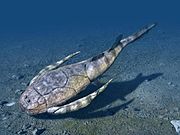Nuciruptor
| Nuciruptor | |
|---|---|
| Scientific classification | |
| Kingdom: | Animalia |
| Phylum: | Chordata |
| Class: | Mammalia |
| Order: | Primates |
| Suborder: | Haplorhini |
| Infraorder: | Simiiformes |
| Family: | Pitheciidae |
| Subfamily: | Pitheciinae |
| Genus: | †Nuciruptor Meldrum & Kay 1997 |
| Species | |
| |
Nuciruptor is an extinct genus of New World monkeys from the Middle Miocene (Laventan in the South American land mammal ages; 13.8 to 11.8 Ma). Its remains have been found at the Konzentrat-Lagerstätte of La Venta in the Honda Group of Colombia. The type species is N. rubricae.[1]
Etymology[]
The name Nuciruptor rubricae is derived from the Latin nuci ("nut") and ruptor meaning "to break".[2] Rubricae refers to the red beds where the fossils have been found.[3]
Description[]
A lower mandible fossil of Nuciruptor was discovered in the El Cardón redbeds of the Cerro Colorado Member of the Villavieja Formation, Honda Group, just below the San Francisco Sandstone which has been dated to the Laventan, about 12.8 ± 0.2 Ma.[2] From the same locality, fossils of Saimiri annectens were recovered.[4]
Nuciruptor resembles living pitheciins in having elongate, procumbent, and styliform lower incisors with very weak lingual heels. Moreover, as in living pitheciins, the incisors are set in a procumbently oriented mandibular symphysis, and its mandibular corpus deepens appreciably under the molars. At the same time, Nuciruptor does not possess several of the distinctive synapomorphies of extant pitheciins. Nuciruptor remains more primitive than living pitheciins in that no diastema separates its lower incisors from the canine. Its lower canines retain the primitive structure in not having a sharply defined protocristid. P2 is not a robust or high-crowned tooth and does not have a metaconid. Nor are the other premolars molarised by the addition of large talonids.[5] The estimated weight of Nuciruptor was 2,000 grams (4.4 lb).[6] The genus shows similarity with another fossil primate from La Venta, Cebupithecia.[7]
As Cebupithecia, Nuciruptor is thought to be an ancestral saki (Pitheciidae).[8][9]
Habitat[]
The Honda Group, and more precisely the "Monkey Beds", are the richest site for fossil primates in South America.[10] It has been argued that the monkeys of the Honda Group were living in habitat that was in contact with the Amazon and Orinoco Basins, and that La Venta itself was probably seasonally dry forest.[11]
See also[]
- List of primates of Colombia
- Lagonimico
- Mohanamico
References[]
- ^ Nuciruptor rubricae in the Paleobiology Database
- ^ a b Kay & Meldrum, 1997, p.409
- ^ Kay & Meldrum, 1997, p.410
- ^ Kay & Meldrum, 1997, p.437
- ^ Kay & Meldrum, 1997, p.421
- ^ Silvestro, 2017, p.14
- ^ Defler, 2004, p.34
- ^ Takai et al., 2001, p.290
- ^ Tejedor, 2013, p.28
- ^ Rosenberger & Hartwig, 2001, p.3
- ^ Lynch Alfaro et al., 2015, p.520
Bibliography[]
- . 2004. Historia natural de los primates colombianos, 1–613. Universidad Nacional de Colombia. Accessed 2017-09-24.
- , and . 1997. The Miocene Fauna of La Venta, Colombia - A new small platyrrhine from the Miocene of Colombia and the phyletic position of the callitrichines, 435–458. Smithsonian Institution Press. Accessed 2017-09-24.
- ; ; , and . 2015. Special issue: Comparative biogeography of Neotropical primates. Molecular Phylogenetics and Evolution 82. 518–529. Accessed 2017-09-24.
- , and . 1997. Nuciruptor rubricae, a New Pitheciin Seed Predator From the Miocene of Colombia. American Journal of Physical Anthropology 102. 407–427. Accessed 2017-09-24.
- , and . 2001. New World Monkeys. Encyclopedia of Life Sciences _. 1–4. Accessed 2017-09-24.
- ; ; ; ; ; ; ; , and . 2017. Evolutionary history of New World monkeys revealed by molecular and fossil data. BioRxiv _. 1–32. Accessed 2017-09-24.
- ; ; ; , and . 2001. A New Platyrrhine from the Middle Miocene of La Venta, Colombia, and the Phyletic Position of Callicebinae. , Tokyo 109.4. 289–307. Accessed 2017-09-24.
- . 2013. Sistemática, evolución y paleobiogeografía de los primates Platyrrhini. Revista del Museo de La Plata 20. 20–39. Accessed 2017-09-24.
Further reading[]
- , and . 2013. The Platyrrhine Fossil Record, 1–256. Elsevier ISBN 9781483267074. Accessed 2017-10-21.
- , and . 2002. The Primate Fossil Record - Miocene platyrrhines of the northern Neotropics, 175–188. Cambridge University Press, ISBN 978-0-521-08141-2. Accessed 2017-09-24.
- Prehistoric primate genera
- Prehistoric monkeys
- Monotypic primate genera
- Miocene genus first appearances
- Miocene extinctions
- Miocene primates of South America
- Laventan
- Neogene Colombia
- Fossils of Colombia
- Honda Group, Colombia
- Fossil taxa described in 1997







